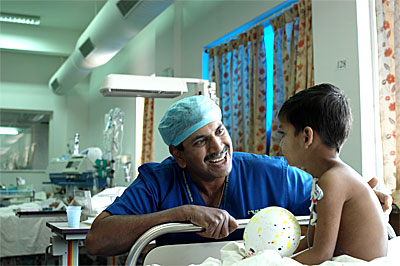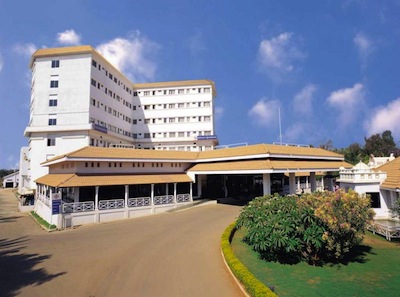Cracking the Code on Affordable Health Care – Part 1: An Interview With Dr. Devi Shetty, Founder of Narayana Hrudayalaya
Editor’s Note: you can read Part 2 of this interview here.
Devi Shetty is India’s most celebrated physician – and one of the world’s most famous surgeons. His patients have included Mother Teresa, and his list of accomplishments is the stuff of legend, including:
- India’s first neonatal open-heart surgery
- The world’s first use of a microchip camera during open-heart surgery to close a hole in the heart
- The first use of an artificial heart in India
But Dr. Shetty’s biggest legacy may be his pioneering work in developing a radically affordable health care model through Narayana Hrudayalaya, one of India’s largest multi-specialty hospital chains. Through a combination of economies of scale and specialization, the hospital provides top-quality care to an astounding number of patients, at a fraction of the cost of hospitals in the developed world.
For instance, it charges an average of $2,000 for open-heart surgery, compared with $20,000-100,000 in the U.S., with success rates similar to the world’s best hospitals. And though it primarily serves the poor, it generates higher profit margins than most private hospitals in the U.S.
Here are a few highlights of their model:
- A sliding scale of fees for surgeries, so wealthier customers subsidize poorer ones
- Mobile clinics sent to nearby rural hospitals to test for heart disease and refer potential customers
- A micro-insurance program backed by the government that provides coverage to 3 million poor customers for extremely low monthly premiums
- Optional private rooms and other revenue-generating perks for wealthier patients, including foreigners
- Daily P&L statements for its surgeons that help them balance their paying and subsidized patients, allow them to add more full payers if necessary (except in the case of urgent health issues).
The company is planning to increase its number of beds from 5,000 to 30,000 by 2017, making it one of the largest health care players in India. It is also expanding aggressively beyond the country’s borders.
NextBillion Health Care spoke recently with Shetty. In part 1 of our interview, we discuss how Narayana Hrudayalaya has cracked the code on affordable health care, and the sacrifices their model entails.
James Militzer: You’ve said that people have complicated the natural art of healing, making us turn to expensive solutions. Why do you think we’ve complicated it, and what’s your way to solve it inexpensively?
Devi Shetty: In New York, there are hospitals coming up costing $600 million. And we are building hospitals here – we have just built a hospital near Bangalore for $6 million. So first of all, we should ask ourselves, do we really need to build a complex structure? We live in houses without central air conditioning, why do we need hospitals with central air conditioning in the patient rooms?
Why do you need patients to be taken care of, after surgery, in the ward, by the nurses? We can always train the spouse or the family members to take care, so that when the patient goes home, there will be continuity of care. We are working to develop a curriculum of four hours, to train family members to be the nursing care providers in the hospital three days before the patient goes home.
And we have the infrastructure to perform 60 major heart surgeries a day. These are heart operations, not angiograms. In the U.S., they do about one or two heart surgeries a day in each hospital. We do about 25-35. When you do that kind of number, your costs go down significantly.
JM: So it all comes down to volume?
DS: Yeah. It’s a numbers game. The health sector is extremely sensitive to numbers. As you increase the number, your results get better and your costs go down significantly, because you buy a huge number of products.
JM: How do you manage the cost of your medical staff?
 DS: First of all, in India, the salary structure and cost of living is a fraction of what it is in the U.S. The cost of medicines is perhaps the lowest in the world. And in Europe, doctors work 48 hours a week, whereas we work 14-15 hours a day.
DS: First of all, in India, the salary structure and cost of living is a fraction of what it is in the U.S. The cost of medicines is perhaps the lowest in the world. And in Europe, doctors work 48 hours a week, whereas we work 14-15 hours a day.
We become better doctors by working long hours. In Europe, doctors, especially doctors in training, want to work long hours because there’s no other way that they can get experience. But the law doesn’t allow them to work longer than 48 hours. So in the process, these young surgeons who are going to a residency program, by the time they become experienced surgeons, it’s time for them to retire.
(Left: a Narayana Hrudayalaya doctor with patient)
JM: Is there any point at which quality starts to suffer, if a doctor works too much?
DS: No, quality always improves. We are only technicians. We keep on operating, we get good at it. Like in the U.S., the average cardiac surgeon does about 2,000 surgeries in his whole life. We have surgeons who have done more than 3,000 surgeries, and they’re only in their 30s. You can imagine the expertise that they have, at that young age.
JM: Does that kind of work schedule ever become a burden to doctors’ lifestyle?
DS: You know, when you talk about lifestyle, lifestyle is important in many professions. But nobody forces you to become a surgeon. You choose to. When somebody becomes a doctor, he has to decide what he wants to do. If he wants to have a good lifestyle, he can take a simple profession, he can take dermatology or radiology and sit at home and do the reporting. But once he decides to become a heart surgeon or a neurosurgeon, he must be willing to work long hours.
Not every profession is the same. Someone has to sacrifice for others to enjoy their lives. And it is very important that some professions realize that they have a much, much bigger social responsibility than others. It’s your choice, and when you choose to become a doctor or a surgeon, there are some obligations that you have to respect.
JM: I’ve heard you quoted as saying “Charity is not scalable. If you give something away for free, you will run out of money.” But you were also Mother Theresa’s surgeon, and I understand she had a big impact on you. How do you balance the desire to serve with the desire to make money?
 DS: The desire for many of us is not making money. We are here to make a difference. But in the process, we should not become poorer. We are only becoming wealthier, but money is the byproduct of whatever we do.
DS: The desire for many of us is not making money. We are here to make a difference. But in the process, we should not become poorer. We are only becoming wealthier, but money is the byproduct of whatever we do.
Being close to Mother (Theresa) has taught me a lot of lessons about life. Mother’s favorite teaching for everybody is that the hands that help are holier than the lips that pray.
Right: Narayana Hrudayalaya Institute of Cardiac Sciences, Bangalore
JM: How might your model apply to developed countries like the U.S.? For example, you mentioned that you get patients’ families involved in nursing duties, and that you reduce infrastructure costs by making hospitals less luxurious. Do you think that kind of approach could work with customers that are used to being catered to?
DS: I think, you know, our model is developed for our country, and the U.S. has to develop their own model. But I can tell you that when you run out of money, the brain starts working. When you have money, I can tell you that the brain doesn’t work – that has been our experience.
JM: So you think that the U.S., due to the high cost of health care, will be forced to make these decisions in the near future?
DS: There is no choice. If any country has to spend more than 5 percent of GDP on health care, it’s a matter of time before the country goes bankrupt.
Editor’s Note: click here to read more about Narayana Hrudayalaya’s lean model.
- Categories
- Health Care, Social Enterprise
